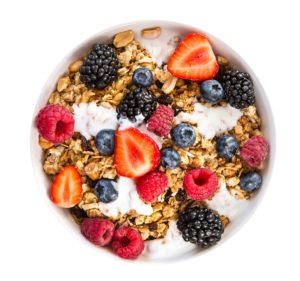Wellness
Question of the Month
It will soon be easier for consumers to make better food and beverage decisions when eating out or on the go. The U.S. Food and Drug Administration (FDA) has moved forward with a food labeling law that requires restaurants, grocery stores and convenience stores with 20 or more locations to post calorie counts for standard menu items. Proponents say calorie disclosures on everything from muffins to lattes to Happy Meals will offer more transparency and will likely encourage diners to downsize their consumption.
Food, Not Pills
Count this as more proof that we shouldn’t rely on pills and powders to make up for dietary shortfalls.
Are Healthy Eaters Wasteful?
Eating a diet based on whole foods deserves a thumbs-up. What’s hard to swallow, however, is that doing so might contribute to the heaps of food wasted in the United States.
Keto—Fat Chance of Performing Better
The ketogenic diet, a fat-forward meal plan that limits followers to about 20 grams of daily carbs, may help some people shed a little weight (in the short term), but it might not be good news for their athletic pursuits.
Plant Foods Are Good for Our Gut Bugs
Our bodies host a huge population of microorganisms, dubbed the human microbiome. In recent years, the makeup of critters in our guts has been linked to a plethora of conditions, including depression, heart disease and obesity. And now bug-friendly scientists at the University of California, San Diego School of Medicine have presented initial findings from the American Gut Project, a crowdsourced initiative that analyzes people’s survey responses and fecal samples to better understand how things like diet, lifestyle and disease affect the human microbiome.
The New Dairy Queens
One look at the dairy-free milk aisle and it’s clear that food companies are on a tear. Nondairy milk sales in the U.S. increased by 61% from 2012 to 2017, according to the research firm Mintel. For a variety of reasons, from lactose intolerance to the perceived unhealthfulness of cow’s milk, more consumers are floating their cereal in liquids that no longer seem nontraditional. Here’s how some of the moo-free contenders stack up nutritionally.
Belly Fat vs. Vitamin D
Here’s another good reason for people to reduce their Buddha-bellies: improving their vitamin D status. According to data presented at the 2018 European Society of Endocrinology’s annual meeting in Barcelona, Spain, researchers from the Netherlands found that more body fat around adults’ waistline is associated with lower vitamin D levels. Beyond raising the risk of weak bones, poor vitamin D status could set the stage for other health issues, including heart disease and compromised immunity.
Ask the RD
Question: I have a sensitivity or allergy to tomatoes. My mouth and esophagus get itchy and sore when I eat them. Is there any way to make tomatoes less irritating? Is there a good substitute for tomatoes in recipes?
Answer: You may suffer from oral allergy syndrome (OAS), a relatively common reaction to plant foods, including tomatoes. People who have pollen allergies are more likely to have OAS (Asero 2013) because they react to similar proteins in vegetables, fruits and/or nuts.
Time to Snub the Clubs?
The prospect of getting extra bang for their food buck has more people perusing
warehouse-style club stores like Costco and Sam’s Club. But the urge to stockpile large amounts of food in the house may lead to calorie overload.
Portion Distortion
No wonder social media feeds are packed with pictures of overflowing smoothie bowls: It appears people feel the types of foods they consume play a bigger role in their health goals than the volume they eat. As a result, a study from Vanderbilt University published in Management Science suggests that those who are trying to maintain a healthy body weight or wishing to shed a few pounds might be prone to overeating “healthy” items like nuts, granola and avocados. The upshot: The public should be educated about practicing portion control—for foods of all kinds.
Snacks Are a Workplace Hazard
Many people can’t resist the temptation of homemade chocolate chip cookies in the break room or leftover Halloween candy circulating among the cubicles. A Centers for Disease Control and Prevention study of 5,222 employees across the U.S., using data from the U.S. Department of Agriculture’s National Household Food Acquisition and Purchasing Survey, documented this challenge.
Twitter’s Former CEO Shuts Down Fitness App Startup
Unable to solve the challenge of how to support positive behavioral change, Dick Costolo, former CEO of Twitter, decided in February to shut down Chorus, a social fitness app that began beta testing in April 2017. The app was designed to use a “chorus” of friends as team members and have them support each other in achieving self-proclaimed weekly fitness or other health-related goals.
New Mindful Outdoor Leadership Program
As green exercise and the health benefits of spending time in nature gain more prominence in popular and scientific news, the Kripalu Center for Yoga & Health in Stockbridge, Massachusetts, is introducing a Mindful Outdoor Leadership Program in October.
The curriculum includes elements of forest bathing, Ayurveda, yoga, outdoor skills, and research related to nature’s health benefits.
Exercise and the Gut Microbiome
New research suggests that endurance exercise positively affects the gut microbiome, but only for lean individuals and only for as long as exercise continues. Researchers at the University of Illinois at Urbana-Champaign conducted the study with 32 sedentary men and women—some lean, some obese. The purpose was to explore the impact of endurance exercise on the composition, functional capacity and metabolic output of gut microbiota. Investigators collected samples from the subjects before and after 6 weeks of exercise, then after 6 weeks of no exercise.
Obesity Linked to Lack of Sleep in Childhood
Enforcing bedtime rules may be an important factor in helping kids maintain healthy weight levels. A comprehensive research review of 42 studies with 75,499 participants, conducted by University of Warwick researchers in Coventry, England, found that short sleep durations in infants, children and adolescents were a risk factor for gaining weight and developing obesity. Data analysis showed that children and teens who slept less than others of the same age gained more weight as they grew older and were more likely to become overweight or obese.
The Importance of Exercise for Addiction Recovery
Substance use disorder can wreak havoc on people’s lives. Fitness activity can be a
transformative way for those in recovery to heal, rebuild their lives and find a community of healthy supporters.
According to a study published in Mental Health and Physical Activity in 2011, patients with substance use disorder who exercised while in recovery reported feeling greater strength, improved health, a sense of accomplishment, and increased confidence about staying clean and sober.
Comprehensive Research Project on How to Create an Exercise Habit
24 Hour Fitness® is partnering with the University of Pennsylvania Behavior Change for Good Initiative [BCFG] to support research into what works best for creating lasting exercise habits. With an interdisciplinary team of world-renowned researchers, the BCFG addresses the broader question of how to make positive behavior change stick in aspects of life related to health, education and savings.
Study Launched on Molecular Changes Related to Exercise
In April, Louisiana State University researchers in Baton Rouge held a training for 120 scientists to kick off a national research consortium designed to create a comprehensive map of the body’s molecular responses during and after exercise. The purpose of the $170 million, multicenter, 6-year research project is to promote understanding of how physical activity improves health and prevents disease.
The Connection Between Inactivity and Obesity
Can we say that inactivity and obesity are directly related? Scientists are still addressing this issue. The 2018 Physical Activity Council Participation Report shows that 82.4 million people—28% of the American population—are inactive. At the same time, the Centers for Disease Control and Prevention reports that more than one-third (36.5%) of U.S. adults are obese (NCHS Data Brief, No. 219, November 2015).
Question of the Month
When you offer training advice to clients, are you discussing the significance of sleep? If yes, are you using sleep trackers and monitoring results? Please describe how you are educating clients regarding the role of sleep in effective training and weight management and share any success stories you have had.
Share your responses with executive editor Joy Keller, jkeller@ideafit.com.

















